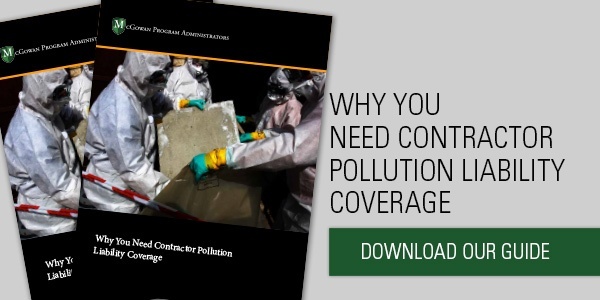Contractors can face crushing liabilities if their commercial general liability insurance policy contains a pollution exclusion.
After all, pollution and contamination trigger expensive lawsuits against contractors. A commercial general liability (CGL) policy that excludes pollution coverage could leave contractors on the hook for damages from:
- Spreading contaminated soils. A contractor who moves fill dirt from one site to another may find out later that the soil was contaminated with a toxin like PCBs.
- Disturbing mold, lead paint, or asbestos. A renovation contractor might drill through a wall and dislodge toxins that become airborne and are distributed through heating and air conditioning ducts.
- Disturbing unknown underground storage tanks (UST) or pipelines. Abandoned industrial sites often have buried tanks with lubricants, fuels, acids, and other dangerous substances. New construction often unearths these hazards.
- Causing fire that results in contamination. An electrical contractor working at a waste processing facility causes a fire and resulting explosion that ruptures a waste tank and causes a leak onto a nearby property.
Contractors need protection against these liabilities, but they cannot count on their
CGL policy to protect them because they often contain explicit pollution exclusions.
Limitations in CGLs
CGL policies insure businesses against tort liability claims arising from negligence, which typically means failing to account for common business risks. An informed risk management program encourages companies to adopt safe, prudent practices to protect people, prevent property damage, and keep insurance rates low. Contracts requiring insurance coverage strengthen companies’ incentive for caution.
All businesses need CGLs because accidents happen and even the most prudent workers make mistakes. Contractors can also often become liable for damages without negligence.
Imagine a dig at a former industrial site. An excavation contractor’s backhoe operator hits a rusty old storage tank and releases a cloud of toxic gas. The gas leak sickens a 25-year-old member of a survey team nearby. The surveyor has a rare lung condition, ends up in a coma for seven weeks, and suffers permanent disability.
For the sake of argument, it’s entirely possible the excavation contractor did nothing wrong and followed appropriate dig safe standards. The backhoe operator had years of experience and an unblemished accident record. Every safety protocol was followed to the letter.
Arguably, there’s no negligence because the excavation contractor did everything right and could not have anticipated the buried tank full of toxic gas, much less accounted for the risks. Nevertheless, the contractor’s actions caused the surveyor’s disability. Therefore, the contractor could be liable for the surveyor’s medical costs and lifetime of lost wages.
A pollution exclusion in the excavation contractor’s CGL policy may explicitly exclude paying this kind of claim, but the contractor may still be legally obligated.
Why contractors need environmental coverage
Pollution exclusions started appearing in the 1970s after new environmental laws required businesses to pay for pollution cleanup costs. Pollution ignored for decades suddenly became the responsibility of polluters and, by extension, their insurers.
Insurance companies balked at the potentially stratospheric costs of cleaning up a century’s worth of pollution, so they started implementing pollution exclusions in their policies. (More background in this article from IRMI, the International Risk Management Institute.)
While much of the attention during this time was on owned sites and site contamination, CGL policies across all industries were impacted by the Total Pollution Exclusion. Meanwhile, contractors continued to encounter pollutants in the course of their work that triggered liabilities like the ones we’ve outlined here. In order to fill this gap in coverage, environmental insurance markets were created.
Filling this gap, insurers write specific environmental policies for contractors that include coverage related to a pollution event for:
- Bodily injury
- Property damage
- Cleanup costs to remediate a site to its pre-loss state
- Defense costs
McGowan Program Administrators helps cover these costs with our Contractors’ Pollution Liability coverage.
This coverage can help a broad spectrum of contractors in fields such as:
| HVAC | Oil & gas (no over-the-hole) |
| Painting | Plumbing |
| Carpentry | Sewer & water main |
| Janitorial services | Siding and window installation |
| Concrete construction | UST/AST installation |
| Drilling (non-oil and gas) | Soil excavation |
| Electrical | Septic tank install/removal |
| Hydroblasting | Landscaping |
The wrong time to find out about pollution exclusions in your CGL policy is after an incident has already happened. Talk to our experts at McGowan to find out if you have enough coverage and how much risk you might face from pollution exclusions.
Related articles:



